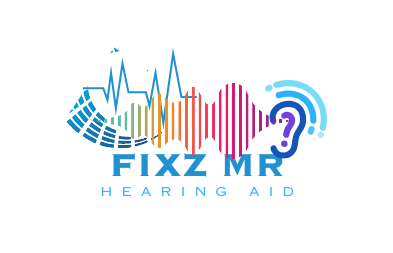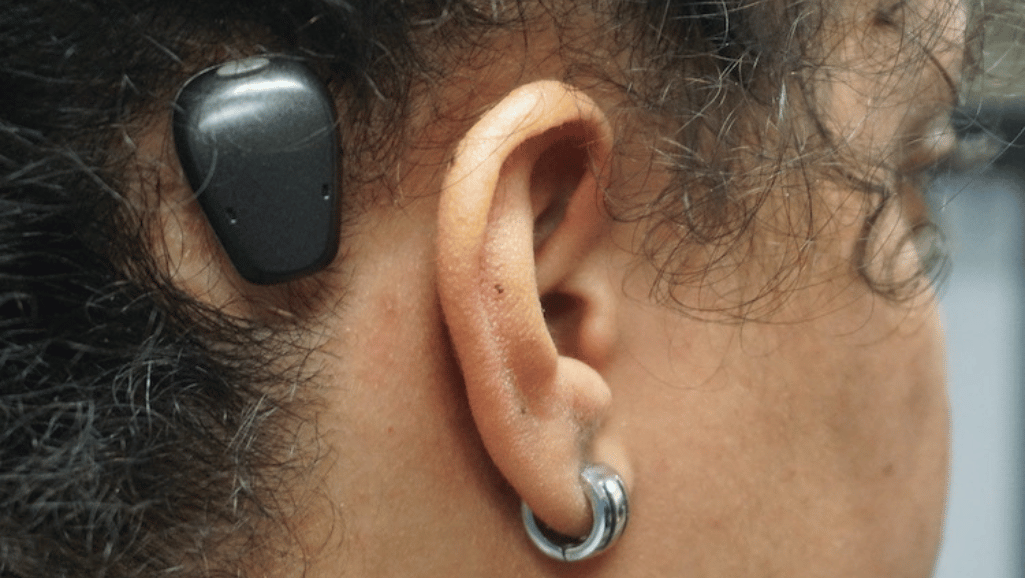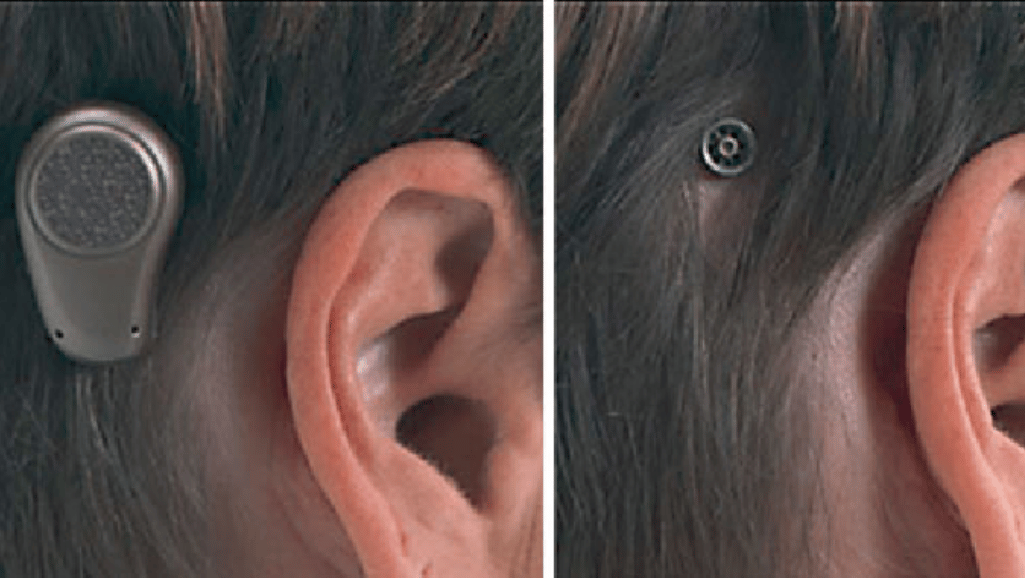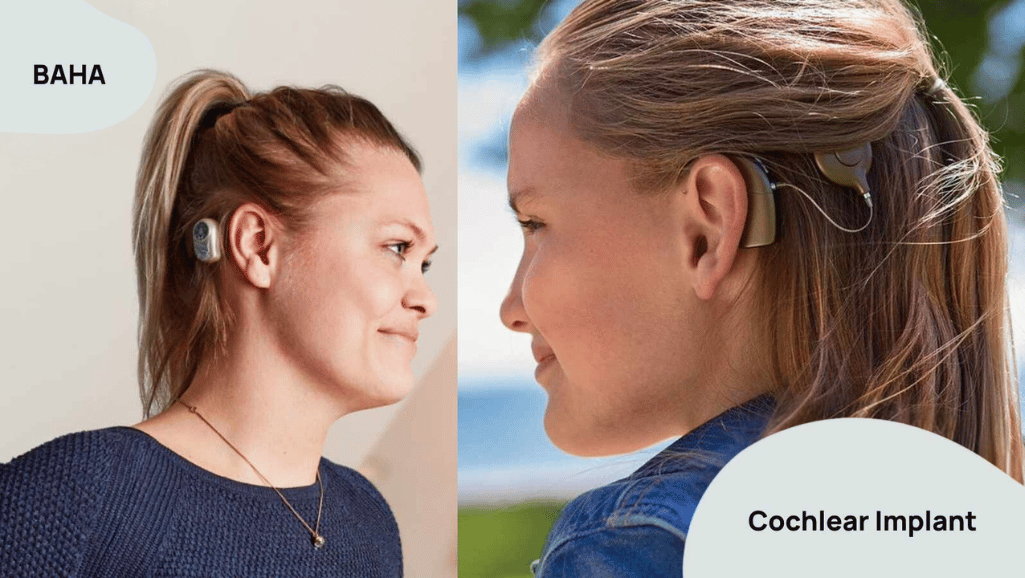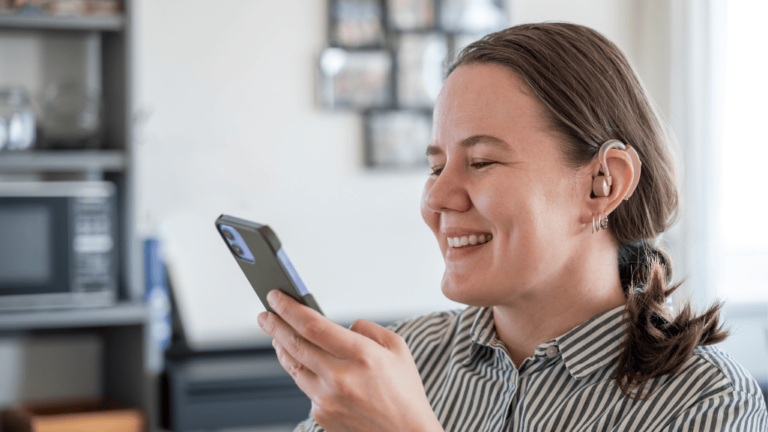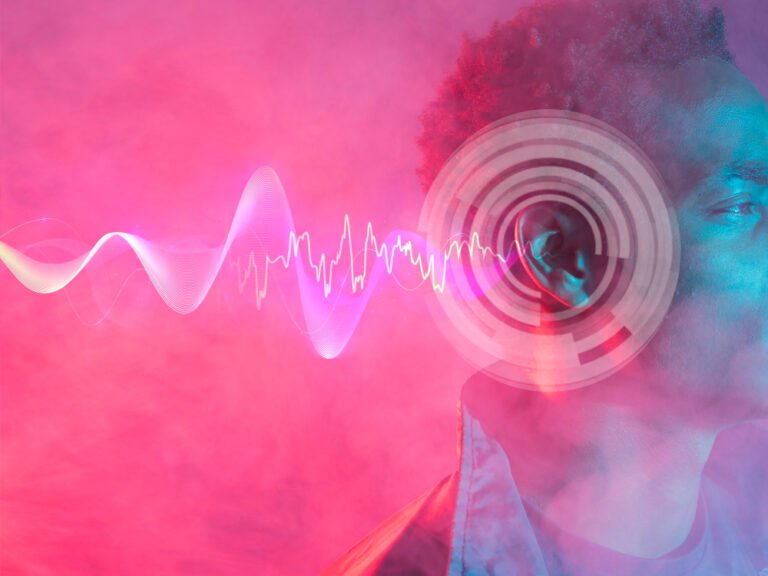The Bone-Anchored Hearing Aid (BAHA) helps people with certain types of hearing loss. It uses vibrations to send sound directly to the inner ear. This skips the usual hearing pathways. Studies, like one reviewing BAHA use, confirm its success.
From 2000 to 2009, 13 patients got BAHA surgery. Seven of them completely closed their hearing gap, and 6 reduced it to just 10 dB. Not a single one had any issues later. This shows BAHA surgery is very safe. It was approved by the FDA for adults in 1996 and kids over 5 in 1999. It has helped improve hearing for many, thanks to a simple process with very few risks.
Key Takeaways
- BAHA hearing aid uses bone conduction to bypass traditional auditory pathways.
- Out of 13 patients between 2000 and 2009, 7 saw a complete closure of the air-bone gap.
- There were no postoperative complications observed in these 13 patients.
- BAHA surgery is FDA approved for adults since 1996 and for children above 5 years since 1999.
- Percutaneous BAHA transmission is approximately 10 to 15 dB more efficient than transcutaneous transmission.
Introduction to BAHA Hearing Aids
BAHA stands for Bone-Anchored Hearing Aids. They are a big step in helping people with hearing issues. These aids work by sending sound directly to the inner ear using bone conduction. They skip the outer and middle ear.
What is a BAHA Device?
BAHA devices are special hearing devices. They send sound straight to the inner ear. This is done through bone conduction, missing the outer and middle ear.
The first BAHA devices came about in the 1970s. Anders Tjellström and Bo Håkansson created them. They were at the forefront of bone-anchored hearing aids. These aids help people, especially those with certain hearing losses, hear better.
The Evolution of BAHA Technology
BAHA technology has improved a lot over time. Early models were simple. But now, they’ve become much better. For example, a study from 2001 showed 40 people had better hearing with BAHA devices.
In 2005, Iwasaki and his team compared BAHA devices to typical hearing aids. They found BAHA devices worked better.
Studies from 2004 also showed that using two BAHA devices was good. They helped improve hearing. In 2005, there was the BAHA Softband. It was a new option for kids with certain hearing problems.
Studies from 2005 showed BAHA devices helped not just with hearing but also how people felt. Another study from 2002 talked about how people liked using BAHA devices in their daily life. They found them very helpful.
The journey of the BAHA technology shows how much effort goes into making better hearing aids. These new BAHA devices show a lot of progress. They help a lot of people hear better and live happier lives.
How BAHA Hearing Aids Work
BAHA hearing aids use a special technology – bone conduction. They send sound vibrations through the skull bones to the inner ear. This way, sound can be heard even if the outer and middle ears don’t work well. A key part of how BAHA works is osseointegration. It means a titanium part in the bone bonds with the skull. This helps the device send sound straight to the ear.
Bone-Conduction Mechanism
This technology lets sound travel straight to the inner ear through bones in the skull. It’s very helpful for people who have trouble hearing through the usual ear areas. For example, those with conductive or mixed hearing loss can benefit. A study with 40 patients showed this method helps them hear better.
Osseointegration Explained
Bone and titanium can grow together in a process called osseointegration. With a titanium piece in the bone, sound can be sent right to the ear in a BAHA. A study checked on 100 early patients and found good and long-lasting results. Patients were happy with how well they could hear.
| Study | Patient Cohort | Outcome |
|---|---|---|
| Lustig LR et al. | 40 Patients | Successful hearing rehabilitation |
| Tjellstrom A, Granstrom G | First 100 patients | Positive clinical outcomes |
| Hol MK et al. | Children with bilateral congenital aural atresia | Enhanced audiological outcomes |
| Arunachalam PS et al. | GBI Assessment | Improved quality of life |
Together, bone conduction and osseointegration make BAHA devices work well for many people with hearing issues.
Who Can Benefit from BAHA Hearing Aids?
BAHA implants help those with conductive, sensorineural, or mixed hearing loss. These devices offer a direct path for sound to reach the inner ear. This is for people who can’t use regular hearing aids.
Indications for BAHA Implants
BAHA surgery is for people who did not do well with traditional hearing aids. This is often for those with conductive hearing loss. It means sound can’t travel well through the outer or middle ear to the inner ear. Also, people with mixed hearing loss may benefit. It’s when both conductive and sensorineural hearing losses are present.
Types of Hearing Loss Addressed
BAHA hearing aids are good for different hearing losses:
- Conductive Hearing Loss: This is when there are blockages or damage in the outer or middle ear. BAHA devices help by sending sound directly to the inner ear.
- Sensorineural Hearing Loss: Less common for BAHA use, this type comes from inner ear or nerve damage. Yet, some with this hearing loss do see benefits from BAHA, especially when regular hearing aids don’t work.
- Mixed Hearing Loss: For mixed hearing loss, BAHA is a good option. It helps with both conductive and some sensorineural issues.
Many studies show BAHA surgeries help a lot. For example, between 2000 and 2009, 13 patients had BAHA surgery. Seven had air-bone gap closure and six achieved a 10 dB gap without problems. BAHA showed good results in unilateral cases too.
The FDA approved BAHA surgery for adults in 1996 and for kids over 5 in 1999. This shows that BAHA is a good option for specific hearing loss types.
The BAHA Surgery Process
The journey of getting a BAHA device starts with important checks and ends with special care. This ensures the device works well and the patient is happy with it.
Pre-Surgical Evaluations
Before surgery, hearing checks play a key role. They help decide if the patient is a good fit for a BAHA, especially kids with ear issues. The check also picks the right type of BAHA based on the patient’s hearing and anatomy.
The Surgical Procedure
The surgery is designed for each patient’s anatomy and the chosen device. It starts by making a mark for a skin cut behind the ear. An anesthetic solution is used to numb the area. The length of the part that sticks out (abutment) is usually a bit longer than the skin’s thickness. Sometimes, mainly with kids, the surgery happens in two steps. First, the implant goes in, then the abutment or magnet later.
| Procedure Type | Benefit | Consideration |
|---|---|---|
| Abutment BAHA | Better hearing outcomes | Allows for MRI scans |
| Magnet BAHA | Less healing time | May have MRI scan issues |
Post-Surgical Care
After the surgery, care is important for a good result and to avoid problems. The patient will see ear, nose, and throat doctors and hearing specialists for updates. They check healing, adjust the device, and solve any issues. It’s important to watch for any signs of infection, especially with the abutment type.
Keep up with check-ups to track how hearing gets better and to learn to use the BAHA right. Most people see big improvement after the surgery, with hardly any problems.
Understanding the BAHA Sound Processor
The BAHA sound processor changes sounds into vibrations through advanced hearing technology. It skips the outer and middle ear, sending these vibrations straight to the inner ear. This amazing process helps people with certain hearing issues.
Advanced BAHA technology has been proven by many studies to be very successful. In adults and children, success rates are very high, over 90%. The device costs about $3,500 and greatly improves sound quality and user satisfaction.
Technology for BAHA has improved a lot. Now, they focus on making the device more comfortable for patients. By doing this, they’ve lowered skin reaction risks to 1% to 2%.
The state of Minnesota in the U.S. helps pay for BAHA devices that the FDA approves. This is for people with certain hearing problems. It covers both when one or both ears need help, but with different rules for each.
BAHA devices greatly boost people’s ability to understand speech. This leads to a better life quality, more confidence, and less irritation. The latest BAHA technology is very advanced and makes a real difference in people’s lives.
BAHA vs Traditional Hearing Aids
When you look at BAHA versus traditional hearing aids, you see various differences. These differences show how each works and what results they bring.
Key Differences
BAHA (Bone Anchored Hearing Aid) sends sound right through the bones of your skull to your inner ear. This skips the usual way sound travels through your outer and middle ear. In contrast, traditional hearing aids boost sound through the air into your ear canal.
Advantages of BAHA Devices
BAHA devices offer some big benefits over usual hearing aids. They help prevent issues like blocking the ear canal and the infections that can come with it. Patients using BAHA systems often find sounds clearer, especially in noisy places, thanks to the direct bone connection.
Studies show people using BAHA have between 73% to 114% better results over time. This high success rate shows how reliable and effective BAHA technology is.
Limitations of Traditional Hearing Aids
While traditional hearing aids help many, they have their limits. They may not work well for people with severe conductive hearing loss or certain ear shape problems. Also, they can vary in how well they work. Users might see only 22% to 30% improvement in their health and 6% to 34% in quality of life.
Another big issue is mechanical impedance. This can be from 85% to 92%, affecting how well the hearing aids work in tough sound conditions.
BAHA Hearing Aid Options
BAHA hearing aids come in different types to fit various needs. They have many models, sound processors, and accessories. Knowing about these options helps people pick the right BAHA device for better hearing. The type of implant and add-ons are crucial for how well the device works.
Implant Models and Features
There are two main BAHA types: abutment and magnet. Abutment BAHAs usually provide better hearing. They are often chosen because they allow for easier MRI scans, which magnet BAHAs restrict.
The choice of BAHA depends on skull bone thickness and whether the patient is young. Some surgeries might need two stages. Studies show BAHA surgery success, with good results for children and those with Down syndrome.
Choosing the Right Sound Processor
Picking the right sound processor is key for good hearing with a BAHA. These processors keep getting better with new tech. Tests show that a good processor is vital for the BAHA’s overall success.
Accessories and Enhancements
BAHA accessories add more to the user’s experience. They include things like wireless devices and protective covers. These extra bits are made to suit a user’s needs and hobbies, so they enjoy their BAHA more.
To summarize the various BAHA model options and their key features:
| Model Type | Advantages | Considerations |
|---|---|---|
| Abutment BAHA | Superior hearing outcomes, MRI compatible | Requires maintenance, visible fixture |
| Magnet BAHA | Less invasive appearance | Possible MRI limitations, generally less effective |
Choosing a BAHA means finding the best mix of implant, processor, and accessories to meet personal hearing and life needs. Talking with healthcare experts helps make the best choice from the available BAHA models.
Benefits of BAHA Hearing Aids
The benefits of the BAHA system are more than just better hearing. Research shows patients get big boosts in hearing and life quality. Many people who get a BAHA implant say they are very happy with it. This shows how well the BAHA works against hearing loss challenges.
In a study from 2000 to 2009, 13 people got a BAHA implant. Seven of them totally fixed their hearing gaps, and six improved by 10 dB. None of them had any problems after the surgery. This means the surgery is safe and gives great results.
The BAHA helps young patients a lot. Kids under 5 see their hearing get much better with it. But, some young patients had more skin or infection issues than older patients after the surgery. Kids who had the whole surgery at once had fewer issues than those who needed two steps.
The BAHA is also good for kids with aural atresia, a rare condition. About 25% with this condition need help in both ears. A study found that kids feel better after getting a BAHA, especially if it was all done at once. They enjoy clearer sounds and feel less pressure. This makes them and their families happier with the BAHA.
Many studies say BAHA devices make a big difference in people’s lives. They give better hearing, which is a big deal for those with hearing problems. They give hope and a real solution for better hearing.
Common Risks and Complications
BAHA surgery is mostly safe and works well. But, like any surgery, there are risks and things that might not go as planned. It’s important for patients to know this.
Potential Surgical Risks
Infection, bleeding, and the implant coming loose are the main risks of BAHA surgery. Doctors do a lot to lower these risks. If a child’s skull is too thin, they might need two surgeries which can make things more risky.
Long-Term Complications
BAHA implants might cause skin irritation or infection over time. Issues are more common with abutment BAHAs but they help you hear better. Magnet BAHAs are safer but they limit MRI use. Remember this when choosing your implant type.
Managing Side Effects
After surgery, you may see swelling and feel uncomfortable. This needs to be treated. Look out for signs of infection and tell your doctor if you notice any. Also, don’t miss your follow-up visits. These check-ups help catch and deal with any problems early.
Recovery and Outlook After BAHA Surgery
Recovering from BAHA surgery is quick for most patients. They can get back to their regular lives soon after. Studies by Gillett et al. (2006) showed that over eight years, people experienced better hearing. This made their life better overall.
Research by Newman et al. (2008) found that people with hearing loss were still happy with their BAHA systems. They enjoyed better hearing for a long time after the surgery. Hearing improved noticeably after the BAHA was put in.
Studies by Estomba et al. (2016) looked at BAHA success over 10 years. They found that taking care of issues quickly kept users happy. Similarly, Cosetti et al. (2016) found that older people’s lives got better after their surgery.
For kids, De Wolf et al. (2011) reported big improvements in life quality after they got a BAHA. This shows that BAHA systems are good for people of all ages. Schneider et al. (2010) also noted that BAHA devices helped with emotional and social needs.
Here is a comparison of life quality improvements before and after BAHA surgery based on different studies:
| Study | Duration | Quality of Life Improvement |
|---|---|---|
| Gillett et al. (2006) | 8 years | Significant benefits using the Glasgow Benefit Inventory |
| Estomba et al. (2016) | 10 years | Identified and managed surgical complications |
| Cosetti et al. (2016) | Post-surgery | Improved life quality in elderly patients |
| Newman et al. (2008) | Longitudinal | Sustained benefits for sensorineural hearing loss |
| De Wolf et al. (2011) | Post-fitting | Enhanced quality of life in children |
| Schneider et al. (2010) | Post-surgery | Increased use of community and informal supports |
Cost and Insurance Coverage for BAHA Hearing Aids
The price of BAHA hearing aids changes a lot. It depends on the surgery and sound processor you pick. Typically, the surgery for a BAHA costs between $10,000 and $17,000. The sound processor itself is around $5,000 to $8,000. This varies by the brand and its features.
Average Costs
| Expense Type | Cost Range (USD) |
|---|---|
| BAHA Surgery | $10,000 – $17,000 |
| Sound Processor | $5,000 – $8,000 |
Insurance Plans and Coverage
Insurance coverage for BAHA aids varies a lot. About 75% of private plans help. These plans see BAHA devices as like regular hearing aids.
Medicare views BAHA devices differently from standard hearing aids. But, Medicare does not help with standard hearing aids right now. Still, a new bill might change this.
Financial Assistance Options
If you need help paying for a BAHA aid, here are some options:
- CareCredit: It’s a special credit card. You can use it for BAHA devices and enjoy special financing deals.
- Health Savings Account (HSA) or Flexible Spending Account (FSA): These accounts can also cover BAHA costs.
- General Purpose Credit Cards: Some providers accept these for payments too.
It’s important for patients to check out these options. They make it easier to pay for the needed hearing aid.
Conclusion
BAHA hearing aids have changed the world of hearing technology. They greatly help people with certain hearing problems. Studies show that these aids really make life better and healthier for users. For example, research from 1985 and 2004 proves its huge benefit.
In 1998, a big study also showed that hearing aids made older people’s lives better.
The BAHA devices have been proven to work well through many studies. These include research from 2001 and 2005. They found that BAHA devices are good for people who hear better with help. They are also becoming more affordable for those who need them most. The new Osia System even goes beyond what was available before, improving sound and being safe for MRI scans without surgery.
When choosing a BAHA solution, it’s important to look at the health and life changes they can bring. New improvements in BAHA technology keep coming. This helps to keep making hearing aids better. It’s also vital to keep studying how else they could help people. This will make sure all patients get the best results possible.
